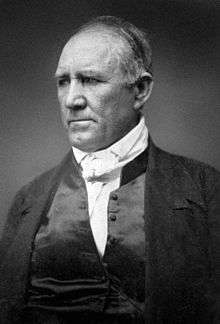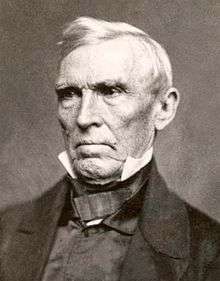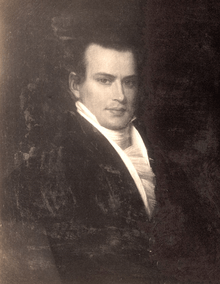1860 Constitutional Union Convention
|
1860 presidential election | |
|
Nominees Bell and Everett | |
| Convention | |
|---|---|
| Date(s) | May 9–10, 1860 |
| City | Baltimore, Maryland |
| Candidates | |
| Presidential nominee | John Bell of Tennessee |
| Vice Presidential nominee |
Edward Everett of Massachusetts |
The 1860 Constitutional Union National Convention met in Baltimore's Eastside District Courthouse, nominating John Bell of Tennessee for president over Governor Sam Houston of Texas on the second ballot. Edward Everett was nominated for vice-president at the convention on May 9, 1860, one week before Lincoln.[1][2]
Background
As the Republican Party strengthened and the Democratic Party fractured, many former Whigs and Know Nothings founded the Constitutional Union Party. who hoped to stave off the danger of secession by avoiding the slavery issue.[3]
Candidates

Constitutional Union candidates:
-

Sam Houston, Texas
Governor[2] -

John J. Crittenden, Kentucky
U.S. Senator[3] -

Edward Everett, Massachusetts
former U.S. Senator[4] -

William A. Graham, North Carolina
former U.S. Senator[5] -

William C. Rives, Virginia
former U.S. Senator[6]
- ^ John Bell was a former U.S. Senator, Speaker of the United States House of Representatives, U.S. Secretary of War
- ^ Sam Houston was a sitting Governor of Texas, former U.S. Senator, President of the Republic of Texas, Governor of Tennessee, and U.S. Representative (Tennessee-7)
- ^ John Crittenden was a sitting U.S. Senator, former U.S. Attorney General, Governor of Kentucky, U.S. Representative (Kentucky-8)
- ^ Edward Everett was a former U.S. Senator, U.S. Secretary of State, U.S. Minister to the United Kingdom, Governor of Massachusetts, U.S. Representative (Massachusetts-4)
- ^ William A. Graham was a former U.S. Senator, Governor of North Carolina, U.S. Secretary of the Navy
- ^ William C. Rives was a former U.S. Senator 1832–1834, and again 1836-1845
John Bell was a former Whig who had opposed the Kansas–Nebraska Act and the Lecompton Constitution. Edward Everett had been president of Harvard University and Secretary of State in the Fillmore administration. The party platform advocated compromise to save the Union, with the slogan: "The Union as it is, and the Constitution as it is."[4]
Balloting
Presidential
| Ballot | 1st | 2nd |
|---|---|---|
| John Bell | 68.5 | 138 |
| Sam Houston | 57 | 69 |
| John J. Crittenden | 28 | 1 |
| Edward Everett | 25 | 9.5 |
| William A. Graham | 22 | 18 |
| John McLean | 21 | 1 |
| William C. Rives | 13 | 0 |
| John M. Botts | 9.5 | 7 |
| William L. Sharkey | 7 | 8.5 |
| William L. Goggin | 3 | 0 |
Vice Presidential
Everett was nominated by voice vote.
References
- ↑ Lossing, Benson John, Pictorial History of the Civil War in the United States of America, Volume 1 (1866) Poughkeepsie, NY. Free ebook. viewed January 26, 2012. p. 29 Bolters met at St. Andrew's Hall.
- ↑ The building had been the First Presbyterian Meeting House (Two Towers Church) on Fayette Street, between Calvert and North Street, demolished before 1866 and occupied by the United States Courthouse.
- ↑ Schulten, Susan (2010-11-10). "How (And Where) Lincoln Won". New York Times, 10 November 2010. Retrieved from http://opinionator.blogs.nytimes.com/2010/11/10/how-and-where-lincoln-won/.
- ↑ Getting the Message Out! Stephen A. Douglas

